Impact of Mood Disorder on Relationships, Work, and Life: A Literature Review
VerifiedAdded on 2022/12/22
|11
|2807
|1
AI Summary
This literature review examines the impact of mood disorder on relationships, work, and different aspects of life. It discusses the cognitive impairment, decreased attention, and worsened thinking skills associated with mood disorder, as well as the impact on employment status. The review highlights the need for interventions to address the consequences of mood disorder on patients' lives.
Contribute Materials
Your contribution can guide someone’s learning journey. Share your
documents today.
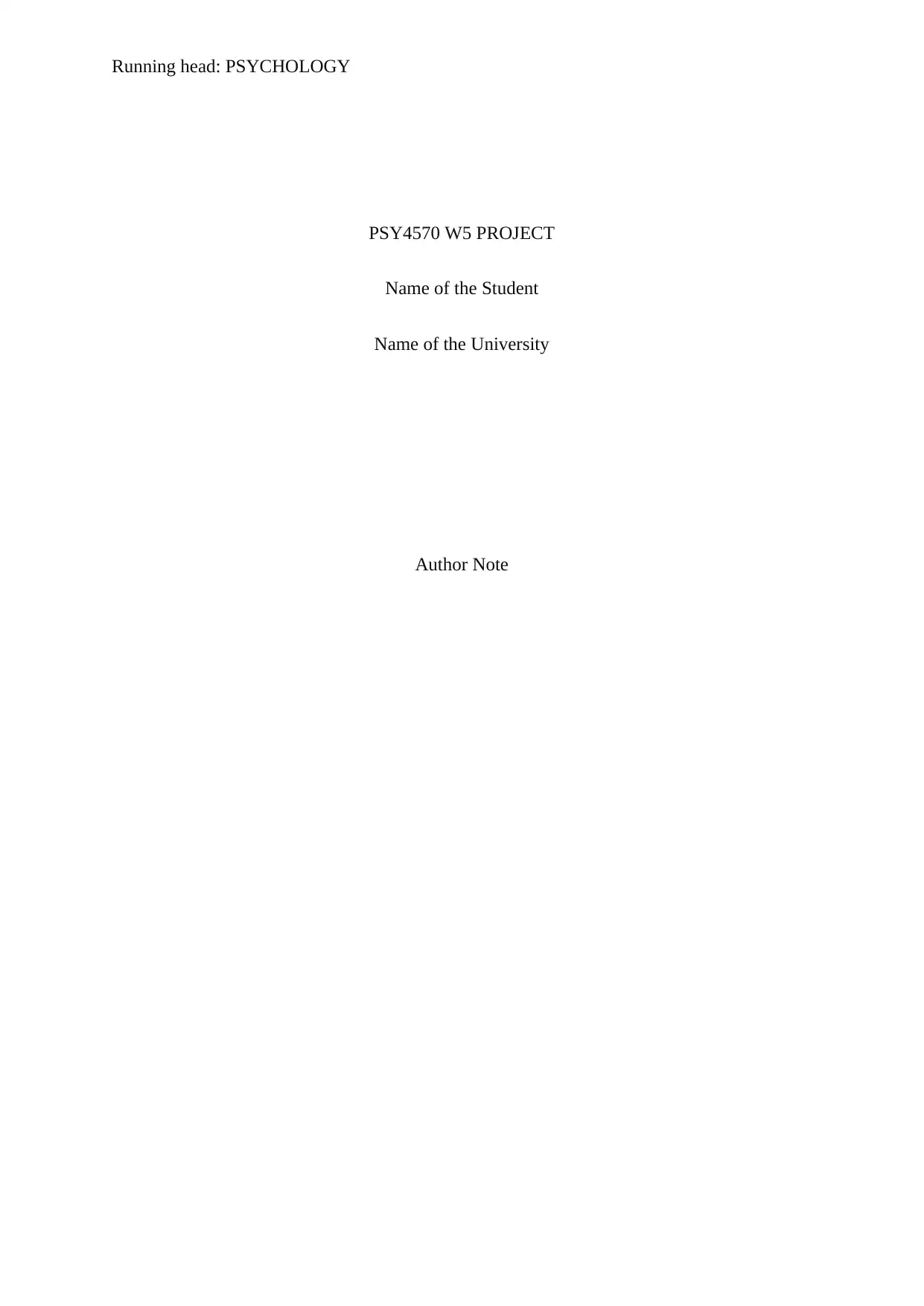
Running head: PSYCHOLOGY
PSY4570 W5 PROJECT
Name of the Student
Name of the University
Author Note
PSY4570 W5 PROJECT
Name of the Student
Name of the University
Author Note
Secure Best Marks with AI Grader
Need help grading? Try our AI Grader for instant feedback on your assignments.
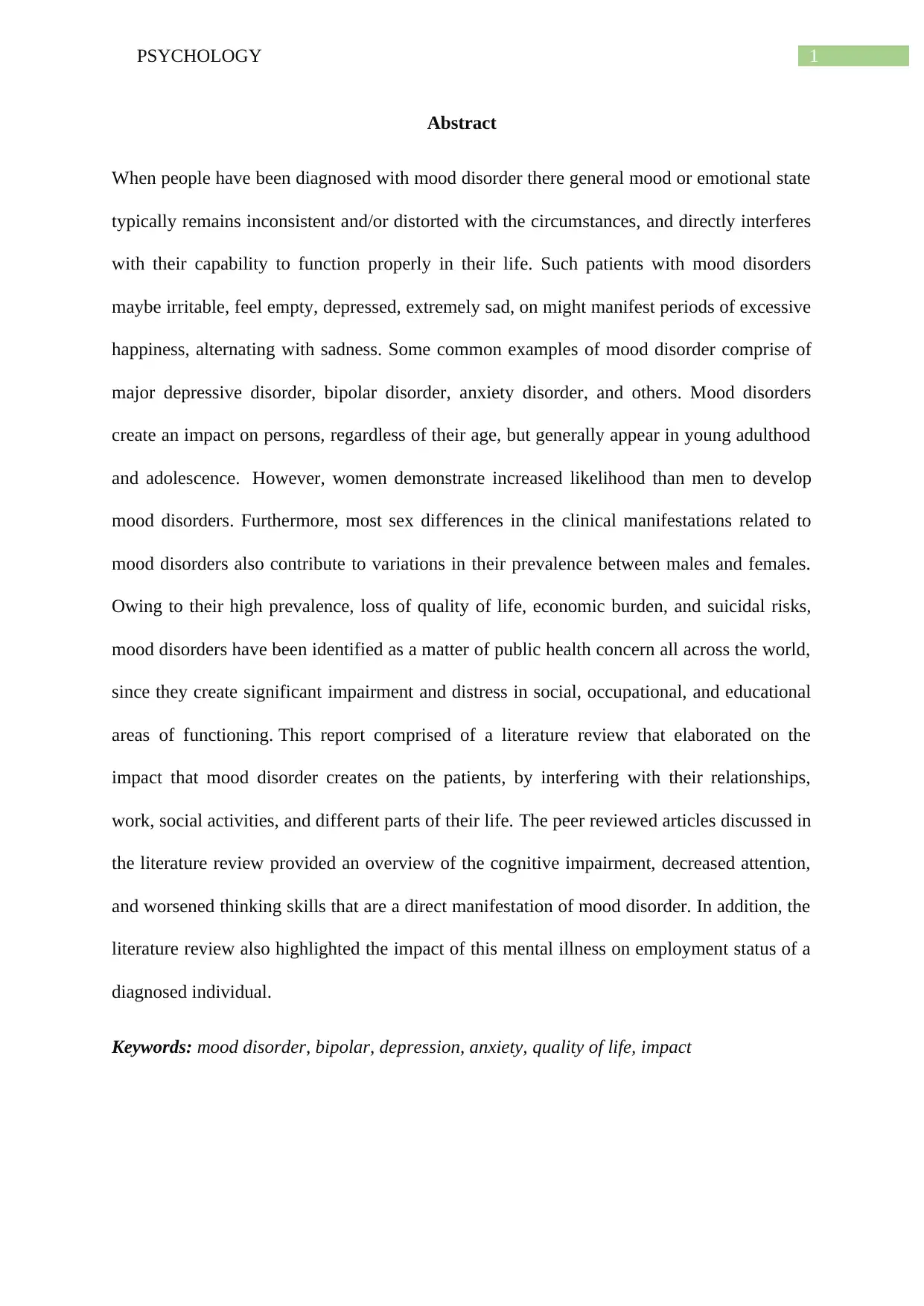
1PSYCHOLOGY
Abstract
When people have been diagnosed with mood disorder there general mood or emotional state
typically remains inconsistent and/or distorted with the circumstances, and directly interferes
with their capability to function properly in their life. Such patients with mood disorders
maybe irritable, feel empty, depressed, extremely sad, on might manifest periods of excessive
happiness, alternating with sadness. Some common examples of mood disorder comprise of
major depressive disorder, bipolar disorder, anxiety disorder, and others. Mood disorders
create an impact on persons, regardless of their age, but generally appear in young adulthood
and adolescence. However, women demonstrate increased likelihood than men to develop
mood disorders. Furthermore, most sex differences in the clinical manifestations related to
mood disorders also contribute to variations in their prevalence between males and females.
Owing to their high prevalence, loss of quality of life, economic burden, and suicidal risks,
mood disorders have been identified as a matter of public health concern all across the world,
since they create significant impairment and distress in social, occupational, and educational
areas of functioning. This report comprised of a literature review that elaborated on the
impact that mood disorder creates on the patients, by interfering with their relationships,
work, social activities, and different parts of their life. The peer reviewed articles discussed in
the literature review provided an overview of the cognitive impairment, decreased attention,
and worsened thinking skills that are a direct manifestation of mood disorder. In addition, the
literature review also highlighted the impact of this mental illness on employment status of a
diagnosed individual.
Keywords: mood disorder, bipolar, depression, anxiety, quality of life, impact
Abstract
When people have been diagnosed with mood disorder there general mood or emotional state
typically remains inconsistent and/or distorted with the circumstances, and directly interferes
with their capability to function properly in their life. Such patients with mood disorders
maybe irritable, feel empty, depressed, extremely sad, on might manifest periods of excessive
happiness, alternating with sadness. Some common examples of mood disorder comprise of
major depressive disorder, bipolar disorder, anxiety disorder, and others. Mood disorders
create an impact on persons, regardless of their age, but generally appear in young adulthood
and adolescence. However, women demonstrate increased likelihood than men to develop
mood disorders. Furthermore, most sex differences in the clinical manifestations related to
mood disorders also contribute to variations in their prevalence between males and females.
Owing to their high prevalence, loss of quality of life, economic burden, and suicidal risks,
mood disorders have been identified as a matter of public health concern all across the world,
since they create significant impairment and distress in social, occupational, and educational
areas of functioning. This report comprised of a literature review that elaborated on the
impact that mood disorder creates on the patients, by interfering with their relationships,
work, social activities, and different parts of their life. The peer reviewed articles discussed in
the literature review provided an overview of the cognitive impairment, decreased attention,
and worsened thinking skills that are a direct manifestation of mood disorder. In addition, the
literature review also highlighted the impact of this mental illness on employment status of a
diagnosed individual.
Keywords: mood disorder, bipolar, depression, anxiety, quality of life, impact
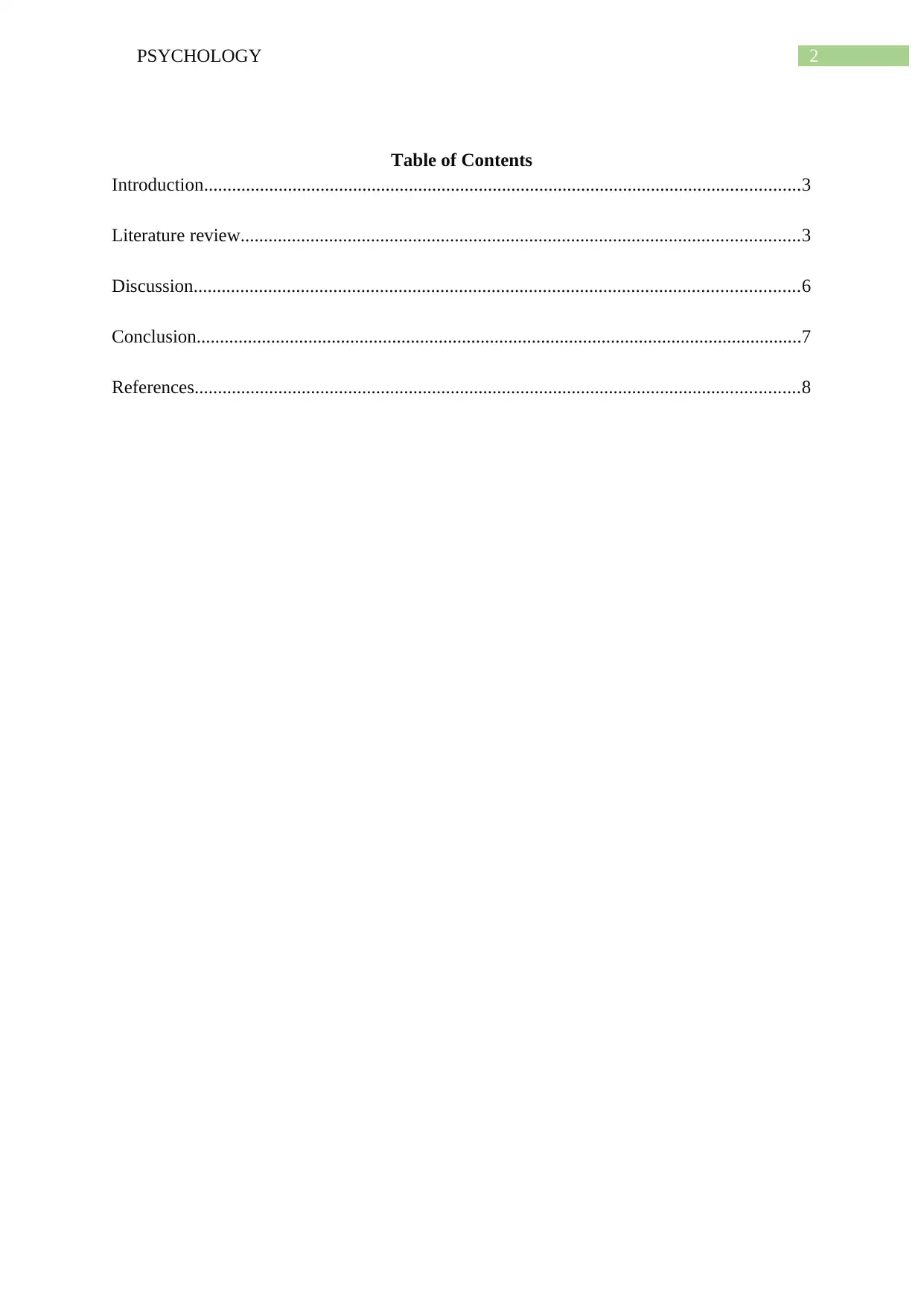
2PSYCHOLOGY
Table of Contents
Introduction................................................................................................................................3
Literature review........................................................................................................................3
Discussion..................................................................................................................................6
Conclusion..................................................................................................................................7
References..................................................................................................................................8
Table of Contents
Introduction................................................................................................................................3
Literature review........................................................................................................................3
Discussion..................................................................................................................................6
Conclusion..................................................................................................................................7
References..................................................................................................................................8
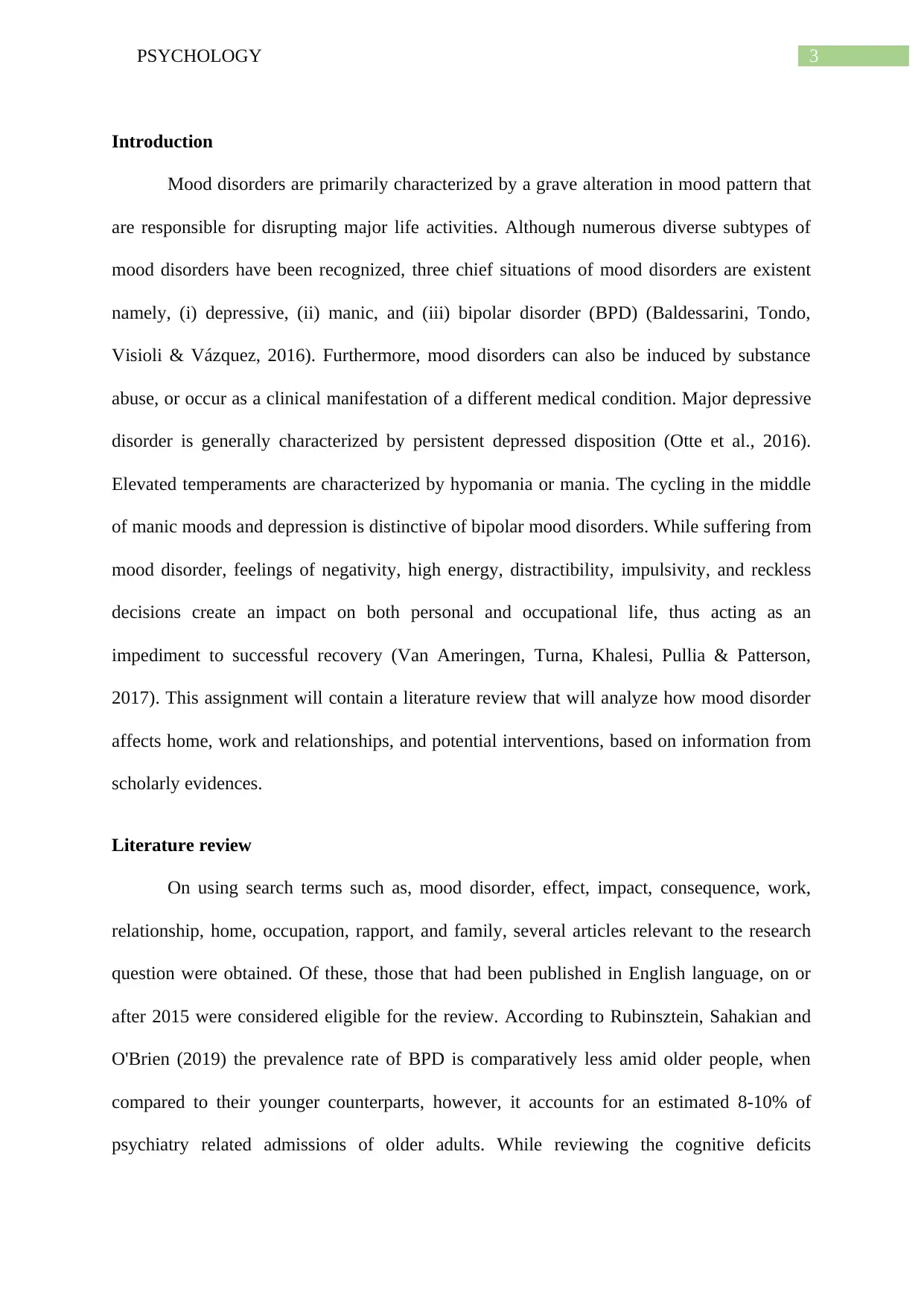
3PSYCHOLOGY
Introduction
Mood disorders are primarily characterized by a grave alteration in mood pattern that
are responsible for disrupting major life activities. Although numerous diverse subtypes of
mood disorders have been recognized, three chief situations of mood disorders are existent
namely, (i) depressive, (ii) manic, and (iii) bipolar disorder (BPD) (Baldessarini, Tondo,
Visioli & Vázquez, 2016). Furthermore, mood disorders can also be induced by substance
abuse, or occur as a clinical manifestation of a different medical condition. Major depressive
disorder is generally characterized by persistent depressed disposition (Otte et al., 2016).
Elevated temperaments are characterized by hypomania or mania. The cycling in the middle
of manic moods and depression is distinctive of bipolar mood disorders. While suffering from
mood disorder, feelings of negativity, high energy, distractibility, impulsivity, and reckless
decisions create an impact on both personal and occupational life, thus acting as an
impediment to successful recovery (Van Ameringen, Turna, Khalesi, Pullia & Patterson,
2017). This assignment will contain a literature review that will analyze how mood disorder
affects home, work and relationships, and potential interventions, based on information from
scholarly evidences.
Literature review
On using search terms such as, mood disorder, effect, impact, consequence, work,
relationship, home, occupation, rapport, and family, several articles relevant to the research
question were obtained. Of these, those that had been published in English language, on or
after 2015 were considered eligible for the review. According to Rubinsztein, Sahakian and
O'Brien (2019) the prevalence rate of BPD is comparatively less amid older people, when
compared to their younger counterparts, however, it accounts for an estimated 8-10% of
psychiatry related admissions of older adults. While reviewing the cognitive deficits
Introduction
Mood disorders are primarily characterized by a grave alteration in mood pattern that
are responsible for disrupting major life activities. Although numerous diverse subtypes of
mood disorders have been recognized, three chief situations of mood disorders are existent
namely, (i) depressive, (ii) manic, and (iii) bipolar disorder (BPD) (Baldessarini, Tondo,
Visioli & Vázquez, 2016). Furthermore, mood disorders can also be induced by substance
abuse, or occur as a clinical manifestation of a different medical condition. Major depressive
disorder is generally characterized by persistent depressed disposition (Otte et al., 2016).
Elevated temperaments are characterized by hypomania or mania. The cycling in the middle
of manic moods and depression is distinctive of bipolar mood disorders. While suffering from
mood disorder, feelings of negativity, high energy, distractibility, impulsivity, and reckless
decisions create an impact on both personal and occupational life, thus acting as an
impediment to successful recovery (Van Ameringen, Turna, Khalesi, Pullia & Patterson,
2017). This assignment will contain a literature review that will analyze how mood disorder
affects home, work and relationships, and potential interventions, based on information from
scholarly evidences.
Literature review
On using search terms such as, mood disorder, effect, impact, consequence, work,
relationship, home, occupation, rapport, and family, several articles relevant to the research
question were obtained. Of these, those that had been published in English language, on or
after 2015 were considered eligible for the review. According to Rubinsztein, Sahakian and
O'Brien (2019) the prevalence rate of BPD is comparatively less amid older people, when
compared to their younger counterparts, however, it accounts for an estimated 8-10% of
psychiatry related admissions of older adults. While reviewing the cognitive deficits
Secure Best Marks with AI Grader
Need help grading? Try our AI Grader for instant feedback on your assignments.
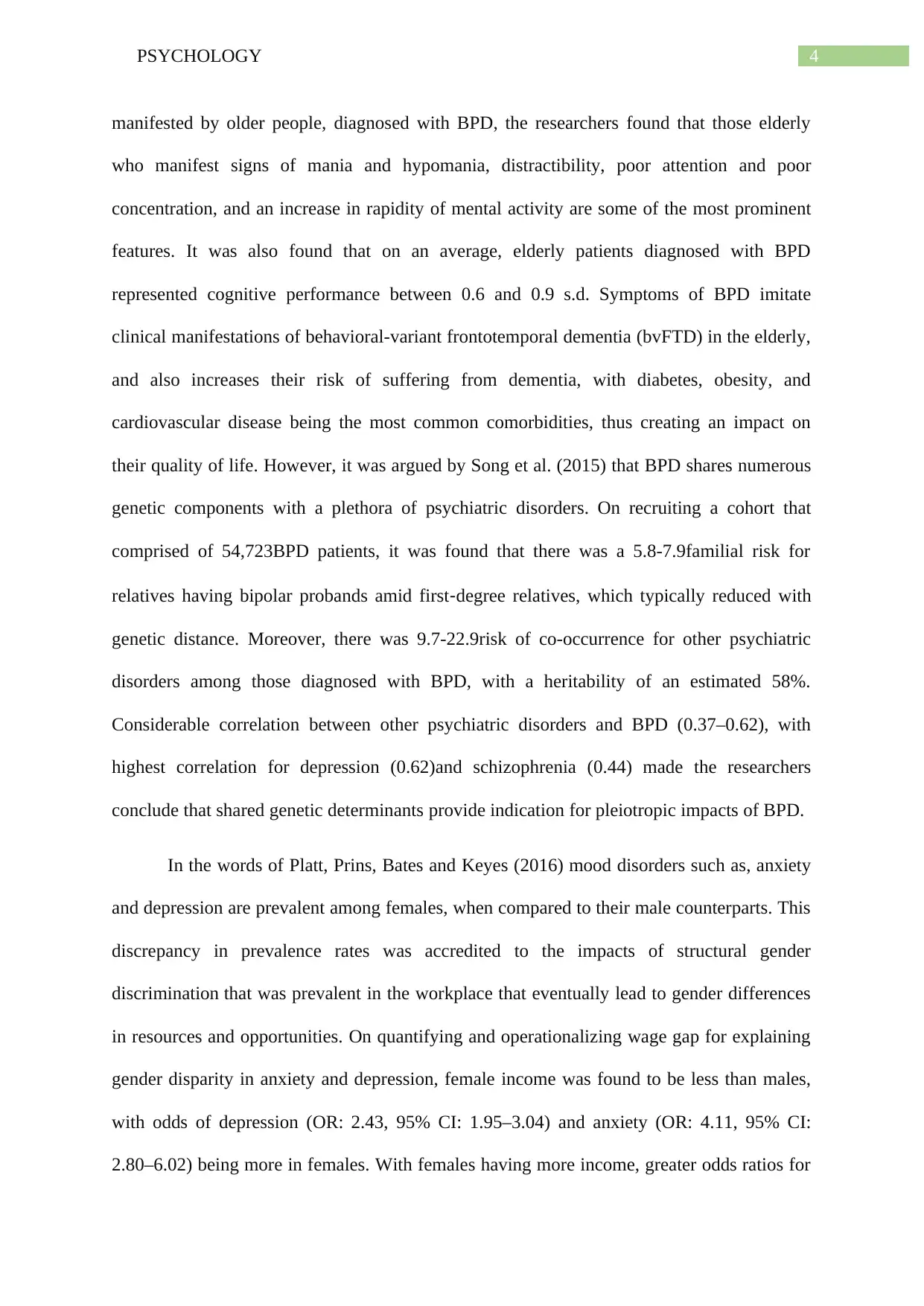
4PSYCHOLOGY
manifested by older people, diagnosed with BPD, the researchers found that those elderly
who manifest signs of mania and hypomania, distractibility, poor attention and poor
concentration, and an increase in rapidity of mental activity are some of the most prominent
features. It was also found that on an average, elderly patients diagnosed with BPD
represented cognitive performance between 0.6 and 0.9 s.d. Symptoms of BPD imitate
clinical manifestations of behavioral-variant frontotemporal dementia (bvFTD) in the elderly,
and also increases their risk of suffering from dementia, with diabetes, obesity, and
cardiovascular disease being the most common comorbidities, thus creating an impact on
their quality of life. However, it was argued by Song et al. (2015) that BPD shares numerous
genetic components with a plethora of psychiatric disorders. On recruiting a cohort that
comprised of 54,723BPD patients, it was found that there was a 5.8-7.9familial risk for
relatives having bipolar probands amid first‐degree relatives, which typically reduced with
genetic distance. Moreover, there was 9.7-22.9risk of co-occurrence for other psychiatric
disorders among those diagnosed with BPD, with a heritability of an estimated 58%.
Considerable correlation between other psychiatric disorders and BPD (0.37–0.62), with
highest correlation for depression (0.62)and schizophrenia (0.44) made the researchers
conclude that shared genetic determinants provide indication for pleiotropic impacts of BPD.
In the words of Platt, Prins, Bates and Keyes (2016) mood disorders such as, anxiety
and depression are prevalent among females, when compared to their male counterparts. This
discrepancy in prevalence rates was accredited to the impacts of structural gender
discrimination that was prevalent in the workplace that eventually lead to gender differences
in resources and opportunities. On quantifying and operationalizing wage gap for explaining
gender disparity in anxiety and depression, female income was found to be less than males,
with odds of depression (OR: 2.43, 95% CI: 1.95–3.04) and anxiety (OR: 4.11, 95% CI:
2.80–6.02) being more in females. With females having more income, greater odds ratios for
manifested by older people, diagnosed with BPD, the researchers found that those elderly
who manifest signs of mania and hypomania, distractibility, poor attention and poor
concentration, and an increase in rapidity of mental activity are some of the most prominent
features. It was also found that on an average, elderly patients diagnosed with BPD
represented cognitive performance between 0.6 and 0.9 s.d. Symptoms of BPD imitate
clinical manifestations of behavioral-variant frontotemporal dementia (bvFTD) in the elderly,
and also increases their risk of suffering from dementia, with diabetes, obesity, and
cardiovascular disease being the most common comorbidities, thus creating an impact on
their quality of life. However, it was argued by Song et al. (2015) that BPD shares numerous
genetic components with a plethora of psychiatric disorders. On recruiting a cohort that
comprised of 54,723BPD patients, it was found that there was a 5.8-7.9familial risk for
relatives having bipolar probands amid first‐degree relatives, which typically reduced with
genetic distance. Moreover, there was 9.7-22.9risk of co-occurrence for other psychiatric
disorders among those diagnosed with BPD, with a heritability of an estimated 58%.
Considerable correlation between other psychiatric disorders and BPD (0.37–0.62), with
highest correlation for depression (0.62)and schizophrenia (0.44) made the researchers
conclude that shared genetic determinants provide indication for pleiotropic impacts of BPD.
In the words of Platt, Prins, Bates and Keyes (2016) mood disorders such as, anxiety
and depression are prevalent among females, when compared to their male counterparts. This
discrepancy in prevalence rates was accredited to the impacts of structural gender
discrimination that was prevalent in the workplace that eventually lead to gender differences
in resources and opportunities. On quantifying and operationalizing wage gap for explaining
gender disparity in anxiety and depression, female income was found to be less than males,
with odds of depression (OR: 2.43, 95% CI: 1.95–3.04) and anxiety (OR: 4.11, 95% CI:
2.80–6.02) being more in females. With females having more income, greater odds ratios for
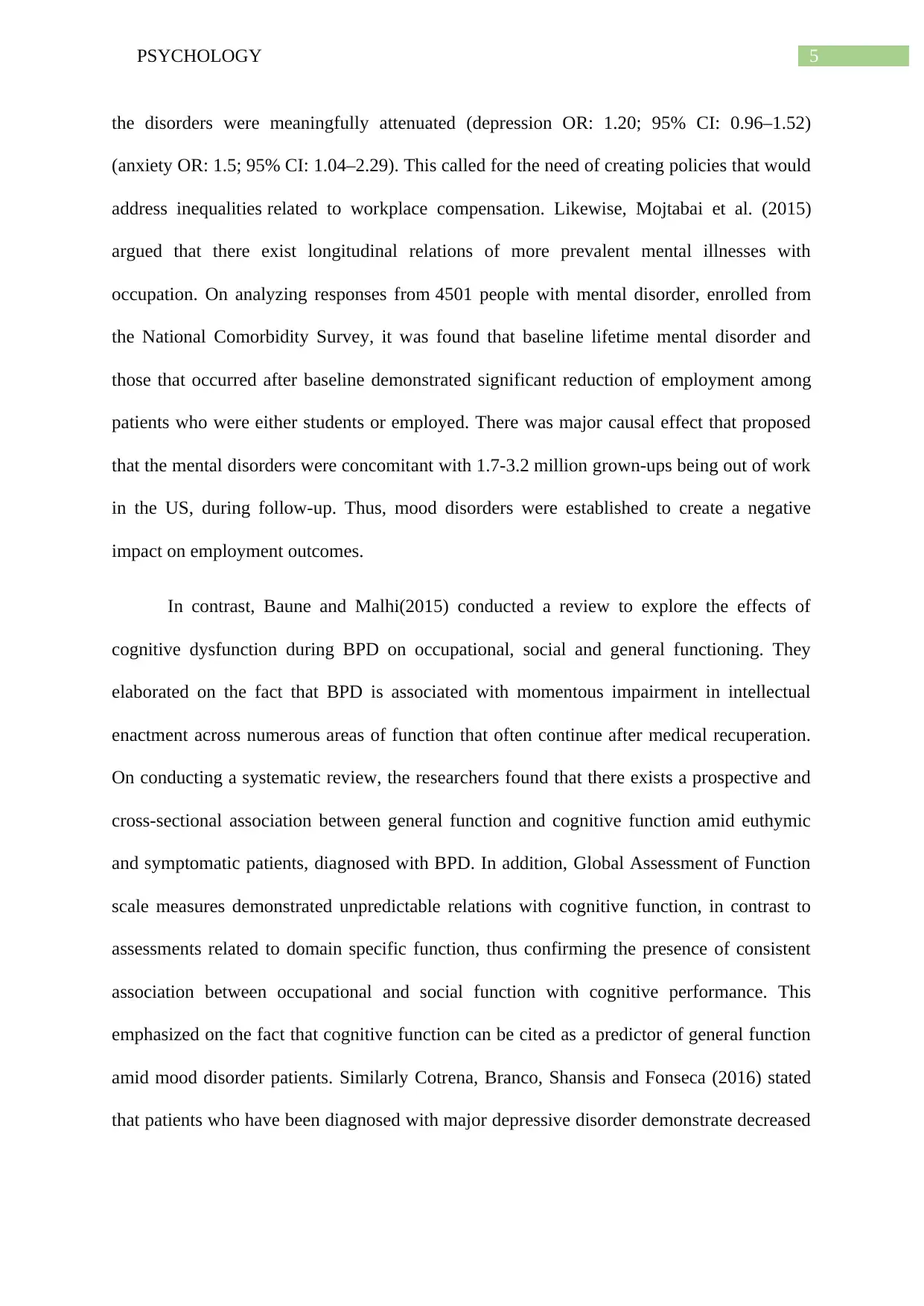
5PSYCHOLOGY
the disorders were meaningfully attenuated (depression OR: 1.20; 95% CI: 0.96–1.52)
(anxiety OR: 1.5; 95% CI: 1.04–2.29). This called for the need of creating policies that would
address inequalities related to workplace compensation. Likewise, Mojtabai et al. (2015)
argued that there exist longitudinal relations of more prevalent mental illnesses with
occupation. On analyzing responses from 4501 people with mental disorder, enrolled from
the National Comorbidity Survey, it was found that baseline lifetime mental disorder and
those that occurred after baseline demonstrated significant reduction of employment among
patients who were either students or employed. There was major causal effect that proposed
that the mental disorders were concomitant with 1.7-3.2 million grown-ups being out of work
in the US, during follow-up. Thus, mood disorders were established to create a negative
impact on employment outcomes.
In contrast, Baune and Malhi(2015) conducted a review to explore the effects of
cognitive dysfunction during BPD on occupational, social and general functioning. They
elaborated on the fact that BPD is associated with momentous impairment in intellectual
enactment across numerous areas of function that often continue after medical recuperation.
On conducting a systematic review, the researchers found that there exists a prospective and
cross-sectional association between general function and cognitive function amid euthymic
and symptomatic patients, diagnosed with BPD. In addition, Global Assessment of Function
scale measures demonstrated unpredictable relations with cognitive function, in contrast to
assessments related to domain specific function, thus confirming the presence of consistent
association between occupational and social function with cognitive performance. This
emphasized on the fact that cognitive function can be cited as a predictor of general function
amid mood disorder patients. Similarly Cotrena, Branco, Shansis and Fonseca (2016) stated
that patients who have been diagnosed with major depressive disorder demonstrate decreased
the disorders were meaningfully attenuated (depression OR: 1.20; 95% CI: 0.96–1.52)
(anxiety OR: 1.5; 95% CI: 1.04–2.29). This called for the need of creating policies that would
address inequalities related to workplace compensation. Likewise, Mojtabai et al. (2015)
argued that there exist longitudinal relations of more prevalent mental illnesses with
occupation. On analyzing responses from 4501 people with mental disorder, enrolled from
the National Comorbidity Survey, it was found that baseline lifetime mental disorder and
those that occurred after baseline demonstrated significant reduction of employment among
patients who were either students or employed. There was major causal effect that proposed
that the mental disorders were concomitant with 1.7-3.2 million grown-ups being out of work
in the US, during follow-up. Thus, mood disorders were established to create a negative
impact on employment outcomes.
In contrast, Baune and Malhi(2015) conducted a review to explore the effects of
cognitive dysfunction during BPD on occupational, social and general functioning. They
elaborated on the fact that BPD is associated with momentous impairment in intellectual
enactment across numerous areas of function that often continue after medical recuperation.
On conducting a systematic review, the researchers found that there exists a prospective and
cross-sectional association between general function and cognitive function amid euthymic
and symptomatic patients, diagnosed with BPD. In addition, Global Assessment of Function
scale measures demonstrated unpredictable relations with cognitive function, in contrast to
assessments related to domain specific function, thus confirming the presence of consistent
association between occupational and social function with cognitive performance. This
emphasized on the fact that cognitive function can be cited as a predictor of general function
amid mood disorder patients. Similarly Cotrena, Branco, Shansis and Fonseca (2016) stated
that patients who have been diagnosed with major depressive disorder demonstrate decreased
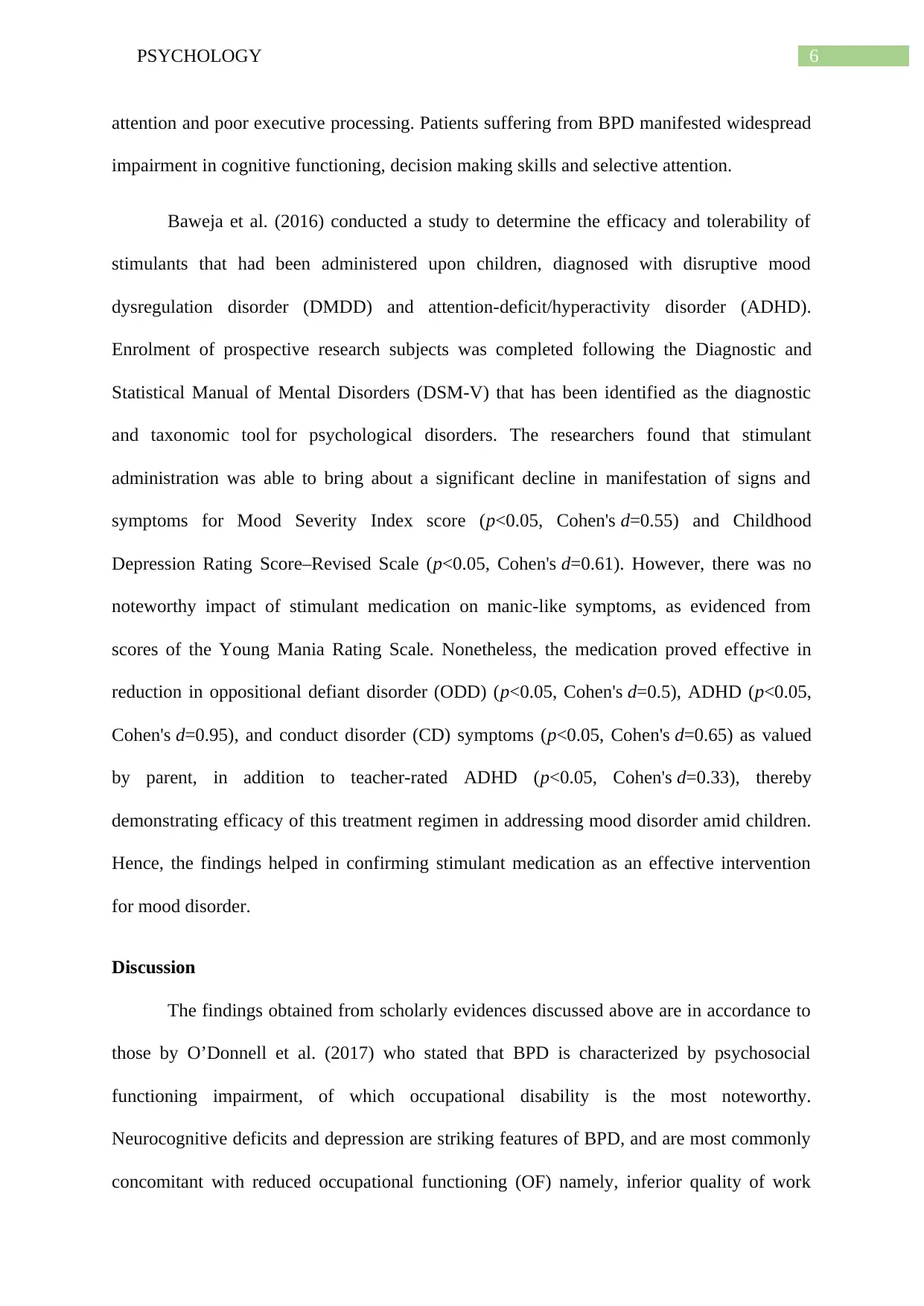
6PSYCHOLOGY
attention and poor executive processing. Patients suffering from BPD manifested widespread
impairment in cognitive functioning, decision making skills and selective attention.
Baweja et al. (2016) conducted a study to determine the efficacy and tolerability of
stimulants that had been administered upon children, diagnosed with disruptive mood
dysregulation disorder (DMDD) and attention-deficit/hyperactivity disorder (ADHD).
Enrolment of prospective research subjects was completed following the Diagnostic and
Statistical Manual of Mental Disorders (DSM-V) that has been identified as the diagnostic
and taxonomic tool for psychological disorders. The researchers found that stimulant
administration was able to bring about a significant decline in manifestation of signs and
symptoms for Mood Severity Index score (p<0.05, Cohen's d=0.55) and Childhood
Depression Rating Score–Revised Scale (p<0.05, Cohen's d=0.61). However, there was no
noteworthy impact of stimulant medication on manic-like symptoms, as evidenced from
scores of the Young Mania Rating Scale. Nonetheless, the medication proved effective in
reduction in oppositional defiant disorder (ODD) (p<0.05, Cohen's d=0.5), ADHD (p<0.05,
Cohen's d=0.95), and conduct disorder (CD) symptoms (p<0.05, Cohen's d=0.65) as valued
by parent, in addition to teacher-rated ADHD (p<0.05, Cohen's d=0.33), thereby
demonstrating efficacy of this treatment regimen in addressing mood disorder amid children.
Hence, the findings helped in confirming stimulant medication as an effective intervention
for mood disorder.
Discussion
The findings obtained from scholarly evidences discussed above are in accordance to
those by O’Donnell et al. (2017) who stated that BPD is characterized by psychosocial
functioning impairment, of which occupational disability is the most noteworthy.
Neurocognitive deficits and depression are striking features of BPD, and are most commonly
concomitant with reduced occupational functioning (OF) namely, inferior quality of work
attention and poor executive processing. Patients suffering from BPD manifested widespread
impairment in cognitive functioning, decision making skills and selective attention.
Baweja et al. (2016) conducted a study to determine the efficacy and tolerability of
stimulants that had been administered upon children, diagnosed with disruptive mood
dysregulation disorder (DMDD) and attention-deficit/hyperactivity disorder (ADHD).
Enrolment of prospective research subjects was completed following the Diagnostic and
Statistical Manual of Mental Disorders (DSM-V) that has been identified as the diagnostic
and taxonomic tool for psychological disorders. The researchers found that stimulant
administration was able to bring about a significant decline in manifestation of signs and
symptoms for Mood Severity Index score (p<0.05, Cohen's d=0.55) and Childhood
Depression Rating Score–Revised Scale (p<0.05, Cohen's d=0.61). However, there was no
noteworthy impact of stimulant medication on manic-like symptoms, as evidenced from
scores of the Young Mania Rating Scale. Nonetheless, the medication proved effective in
reduction in oppositional defiant disorder (ODD) (p<0.05, Cohen's d=0.5), ADHD (p<0.05,
Cohen's d=0.95), and conduct disorder (CD) symptoms (p<0.05, Cohen's d=0.65) as valued
by parent, in addition to teacher-rated ADHD (p<0.05, Cohen's d=0.33), thereby
demonstrating efficacy of this treatment regimen in addressing mood disorder amid children.
Hence, the findings helped in confirming stimulant medication as an effective intervention
for mood disorder.
Discussion
The findings obtained from scholarly evidences discussed above are in accordance to
those by O’Donnell et al. (2017) who stated that BPD is characterized by psychosocial
functioning impairment, of which occupational disability is the most noteworthy.
Neurocognitive deficits and depression are striking features of BPD, and are most commonly
concomitant with reduced occupational functioning (OF) namely, inferior quality of work
Paraphrase This Document
Need a fresh take? Get an instant paraphrase of this document with our AI Paraphraser
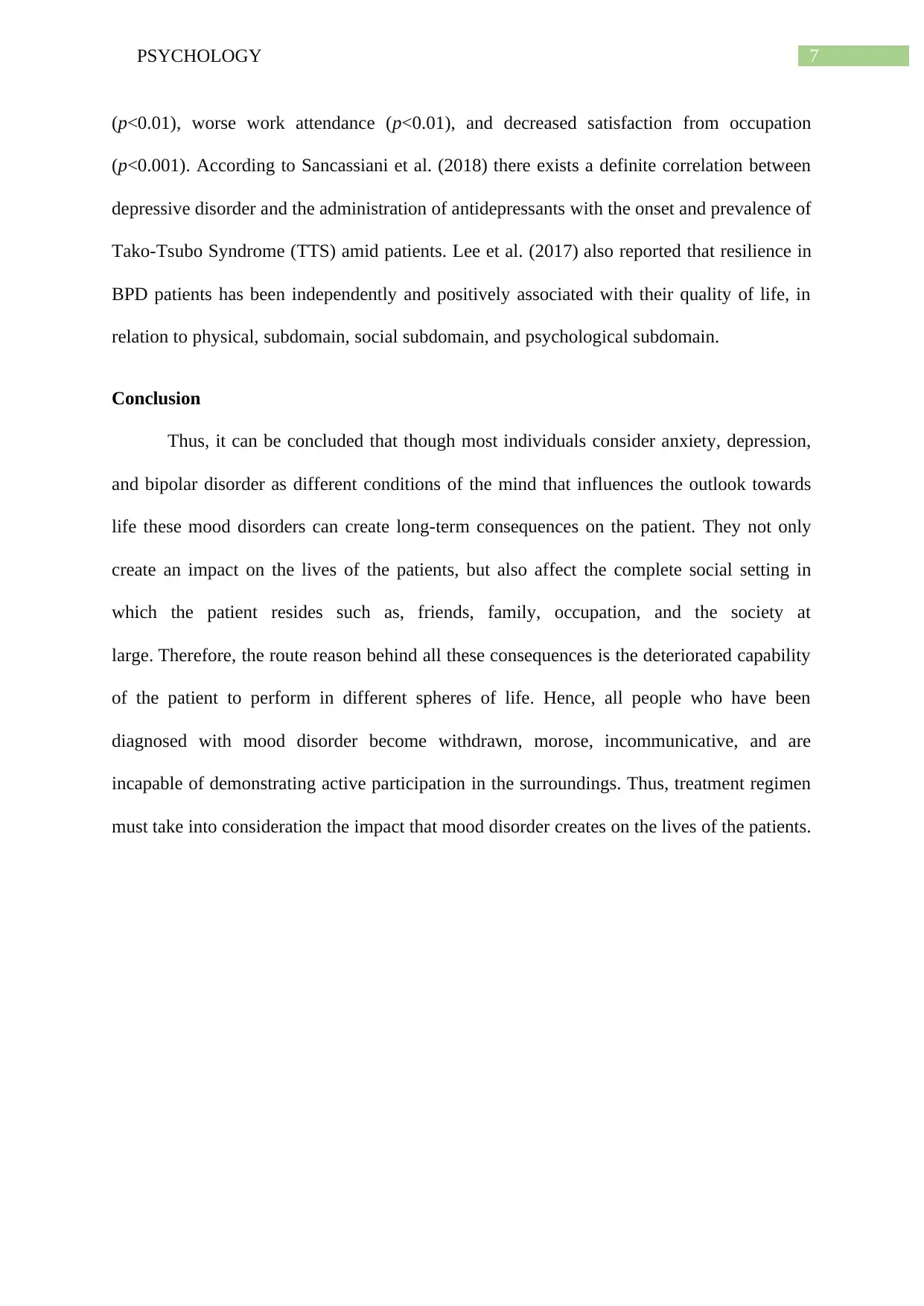
7PSYCHOLOGY
(p<0.01), worse work attendance (p<0.01), and decreased satisfaction from occupation
(p<0.001). According to Sancassiani et al. (2018) there exists a definite correlation between
depressive disorder and the administration of antidepressants with the onset and prevalence of
Tako-Tsubo Syndrome (TTS) amid patients. Lee et al. (2017) also reported that resilience in
BPD patients has been independently and positively associated with their quality of life, in
relation to physical, subdomain, social subdomain, and psychological subdomain.
Conclusion
Thus, it can be concluded that though most individuals consider anxiety, depression,
and bipolar disorder as different conditions of the mind that influences the outlook towards
life these mood disorders can create long-term consequences on the patient. They not only
create an impact on the lives of the patients, but also affect the complete social setting in
which the patient resides such as, friends, family, occupation, and the society at
large. Therefore, the route reason behind all these consequences is the deteriorated capability
of the patient to perform in different spheres of life. Hence, all people who have been
diagnosed with mood disorder become withdrawn, morose, incommunicative, and are
incapable of demonstrating active participation in the surroundings. Thus, treatment regimen
must take into consideration the impact that mood disorder creates on the lives of the patients.
(p<0.01), worse work attendance (p<0.01), and decreased satisfaction from occupation
(p<0.001). According to Sancassiani et al. (2018) there exists a definite correlation between
depressive disorder and the administration of antidepressants with the onset and prevalence of
Tako-Tsubo Syndrome (TTS) amid patients. Lee et al. (2017) also reported that resilience in
BPD patients has been independently and positively associated with their quality of life, in
relation to physical, subdomain, social subdomain, and psychological subdomain.
Conclusion
Thus, it can be concluded that though most individuals consider anxiety, depression,
and bipolar disorder as different conditions of the mind that influences the outlook towards
life these mood disorders can create long-term consequences on the patient. They not only
create an impact on the lives of the patients, but also affect the complete social setting in
which the patient resides such as, friends, family, occupation, and the society at
large. Therefore, the route reason behind all these consequences is the deteriorated capability
of the patient to perform in different spheres of life. Hence, all people who have been
diagnosed with mood disorder become withdrawn, morose, incommunicative, and are
incapable of demonstrating active participation in the surroundings. Thus, treatment regimen
must take into consideration the impact that mood disorder creates on the lives of the patients.
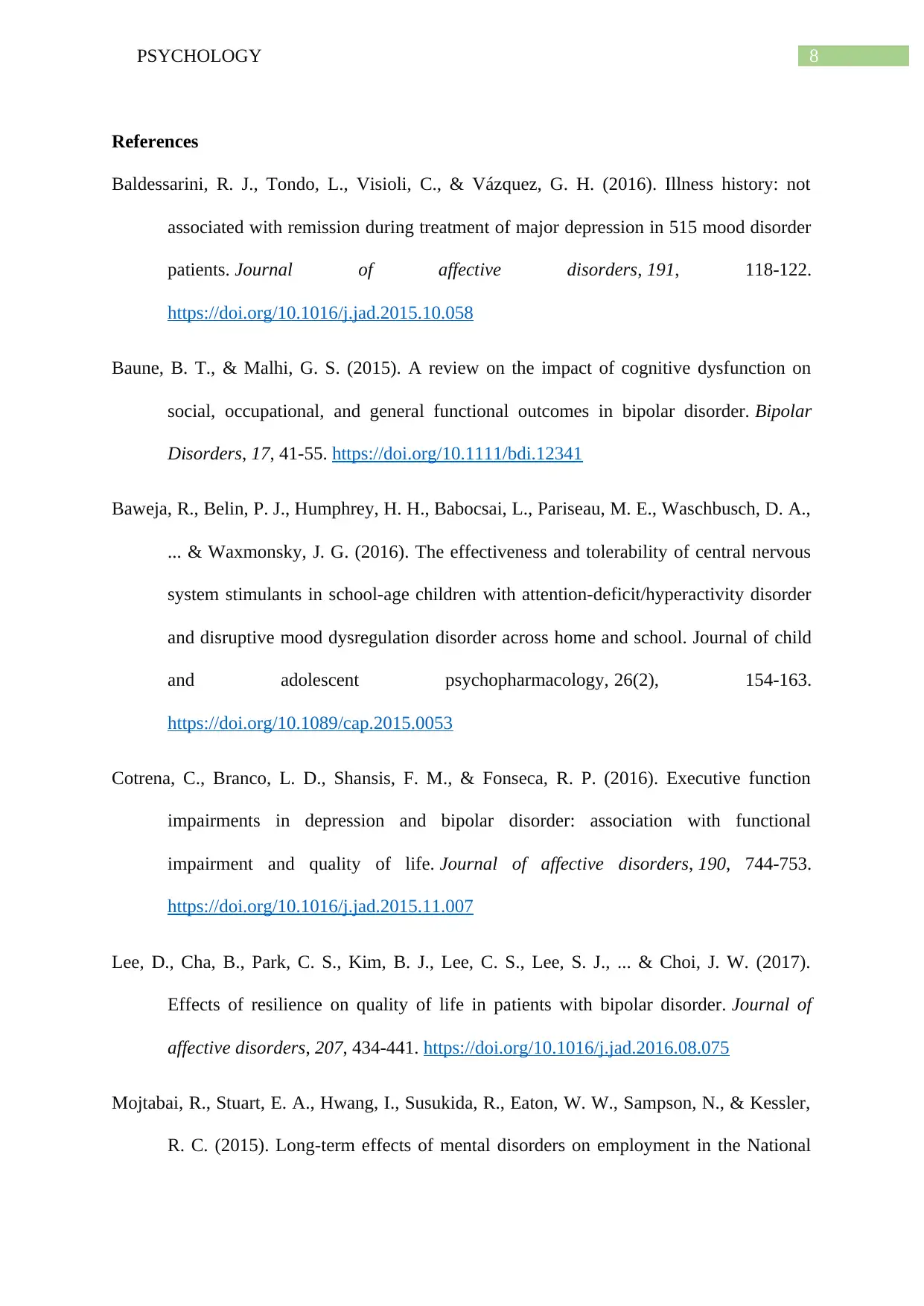
8PSYCHOLOGY
References
Baldessarini, R. J., Tondo, L., Visioli, C., & Vázquez, G. H. (2016). Illness history: not
associated with remission during treatment of major depression in 515 mood disorder
patients. Journal of affective disorders, 191, 118-122.
https://doi.org/10.1016/j.jad.2015.10.058
Baune, B. T., & Malhi, G. S. (2015). A review on the impact of cognitive dysfunction on
social, occupational, and general functional outcomes in bipolar disorder. Bipolar
Disorders, 17, 41-55. https://doi.org/10.1111/bdi.12341
Baweja, R., Belin, P. J., Humphrey, H. H., Babocsai, L., Pariseau, M. E., Waschbusch, D. A.,
... & Waxmonsky, J. G. (2016). The effectiveness and tolerability of central nervous
system stimulants in school-age children with attention-deficit/hyperactivity disorder
and disruptive mood dysregulation disorder across home and school. Journal of child
and adolescent psychopharmacology, 26(2), 154-163.
https://doi.org/10.1089/cap.2015.0053
Cotrena, C., Branco, L. D., Shansis, F. M., & Fonseca, R. P. (2016). Executive function
impairments in depression and bipolar disorder: association with functional
impairment and quality of life. Journal of affective disorders, 190, 744-753.
https://doi.org/10.1016/j.jad.2015.11.007
Lee, D., Cha, B., Park, C. S., Kim, B. J., Lee, C. S., Lee, S. J., ... & Choi, J. W. (2017).
Effects of resilience on quality of life in patients with bipolar disorder. Journal of
affective disorders, 207, 434-441. https://doi.org/10.1016/j.jad.2016.08.075
Mojtabai, R., Stuart, E. A., Hwang, I., Susukida, R., Eaton, W. W., Sampson, N., & Kessler,
R. C. (2015). Long-term effects of mental disorders on employment in the National
References
Baldessarini, R. J., Tondo, L., Visioli, C., & Vázquez, G. H. (2016). Illness history: not
associated with remission during treatment of major depression in 515 mood disorder
patients. Journal of affective disorders, 191, 118-122.
https://doi.org/10.1016/j.jad.2015.10.058
Baune, B. T., & Malhi, G. S. (2015). A review on the impact of cognitive dysfunction on
social, occupational, and general functional outcomes in bipolar disorder. Bipolar
Disorders, 17, 41-55. https://doi.org/10.1111/bdi.12341
Baweja, R., Belin, P. J., Humphrey, H. H., Babocsai, L., Pariseau, M. E., Waschbusch, D. A.,
... & Waxmonsky, J. G. (2016). The effectiveness and tolerability of central nervous
system stimulants in school-age children with attention-deficit/hyperactivity disorder
and disruptive mood dysregulation disorder across home and school. Journal of child
and adolescent psychopharmacology, 26(2), 154-163.
https://doi.org/10.1089/cap.2015.0053
Cotrena, C., Branco, L. D., Shansis, F. M., & Fonseca, R. P. (2016). Executive function
impairments in depression and bipolar disorder: association with functional
impairment and quality of life. Journal of affective disorders, 190, 744-753.
https://doi.org/10.1016/j.jad.2015.11.007
Lee, D., Cha, B., Park, C. S., Kim, B. J., Lee, C. S., Lee, S. J., ... & Choi, J. W. (2017).
Effects of resilience on quality of life in patients with bipolar disorder. Journal of
affective disorders, 207, 434-441. https://doi.org/10.1016/j.jad.2016.08.075
Mojtabai, R., Stuart, E. A., Hwang, I., Susukida, R., Eaton, W. W., Sampson, N., & Kessler,
R. C. (2015). Long-term effects of mental disorders on employment in the National
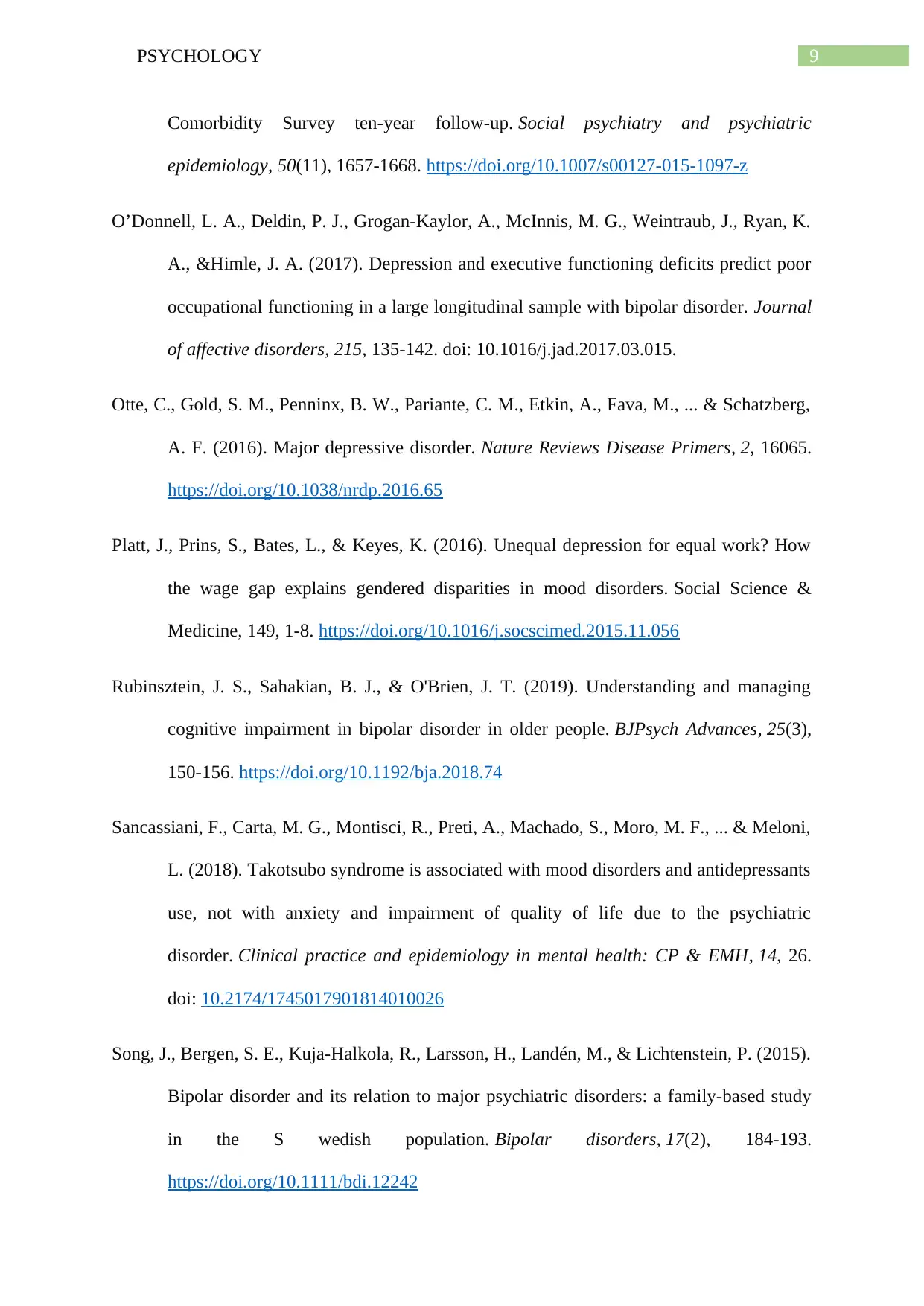
9PSYCHOLOGY
Comorbidity Survey ten-year follow-up. Social psychiatry and psychiatric
epidemiology, 50(11), 1657-1668. https://doi.org/10.1007/s00127-015-1097-z
O’Donnell, L. A., Deldin, P. J., Grogan-Kaylor, A., McInnis, M. G., Weintraub, J., Ryan, K.
A., &Himle, J. A. (2017). Depression and executive functioning deficits predict poor
occupational functioning in a large longitudinal sample with bipolar disorder. Journal
of affective disorders, 215, 135-142. doi: 10.1016/j.jad.2017.03.015.
Otte, C., Gold, S. M., Penninx, B. W., Pariante, C. M., Etkin, A., Fava, M., ... & Schatzberg,
A. F. (2016). Major depressive disorder. Nature Reviews Disease Primers, 2, 16065.
https://doi.org/10.1038/nrdp.2016.65
Platt, J., Prins, S., Bates, L., & Keyes, K. (2016). Unequal depression for equal work? How
the wage gap explains gendered disparities in mood disorders. Social Science &
Medicine, 149, 1-8. https://doi.org/10.1016/j.socscimed.2015.11.056
Rubinsztein, J. S., Sahakian, B. J., & O'Brien, J. T. (2019). Understanding and managing
cognitive impairment in bipolar disorder in older people. BJPsych Advances, 25(3),
150-156. https://doi.org/10.1192/bja.2018.74
Sancassiani, F., Carta, M. G., Montisci, R., Preti, A., Machado, S., Moro, M. F., ... & Meloni,
L. (2018). Takotsubo syndrome is associated with mood disorders and antidepressants
use, not with anxiety and impairment of quality of life due to the psychiatric
disorder. Clinical practice and epidemiology in mental health: CP & EMH, 14, 26.
doi: 10.2174/1745017901814010026
Song, J., Bergen, S. E., Kuja‐Halkola, R., Larsson, H., Landén, M., & Lichtenstein, P. (2015).
Bipolar disorder and its relation to major psychiatric disorders: a family‐based study
in the S wedish population. Bipolar disorders, 17(2), 184-193.
https://doi.org/10.1111/bdi.12242
Comorbidity Survey ten-year follow-up. Social psychiatry and psychiatric
epidemiology, 50(11), 1657-1668. https://doi.org/10.1007/s00127-015-1097-z
O’Donnell, L. A., Deldin, P. J., Grogan-Kaylor, A., McInnis, M. G., Weintraub, J., Ryan, K.
A., &Himle, J. A. (2017). Depression and executive functioning deficits predict poor
occupational functioning in a large longitudinal sample with bipolar disorder. Journal
of affective disorders, 215, 135-142. doi: 10.1016/j.jad.2017.03.015.
Otte, C., Gold, S. M., Penninx, B. W., Pariante, C. M., Etkin, A., Fava, M., ... & Schatzberg,
A. F. (2016). Major depressive disorder. Nature Reviews Disease Primers, 2, 16065.
https://doi.org/10.1038/nrdp.2016.65
Platt, J., Prins, S., Bates, L., & Keyes, K. (2016). Unequal depression for equal work? How
the wage gap explains gendered disparities in mood disorders. Social Science &
Medicine, 149, 1-8. https://doi.org/10.1016/j.socscimed.2015.11.056
Rubinsztein, J. S., Sahakian, B. J., & O'Brien, J. T. (2019). Understanding and managing
cognitive impairment in bipolar disorder in older people. BJPsych Advances, 25(3),
150-156. https://doi.org/10.1192/bja.2018.74
Sancassiani, F., Carta, M. G., Montisci, R., Preti, A., Machado, S., Moro, M. F., ... & Meloni,
L. (2018). Takotsubo syndrome is associated with mood disorders and antidepressants
use, not with anxiety and impairment of quality of life due to the psychiatric
disorder. Clinical practice and epidemiology in mental health: CP & EMH, 14, 26.
doi: 10.2174/1745017901814010026
Song, J., Bergen, S. E., Kuja‐Halkola, R., Larsson, H., Landén, M., & Lichtenstein, P. (2015).
Bipolar disorder and its relation to major psychiatric disorders: a family‐based study
in the S wedish population. Bipolar disorders, 17(2), 184-193.
https://doi.org/10.1111/bdi.12242
Secure Best Marks with AI Grader
Need help grading? Try our AI Grader for instant feedback on your assignments.

10PSYCHOLOGY
Van Ameringen, M., Turna, J., Khalesi, Z., Pullia, K., & Patterson, B. (2017). There is an app
for that! The current state of mobile applications (apps) for DSM‐5 obsessive‐
compulsive disorder, posttraumatic stress disorder, anxiety and mood
disorders. Depression and anxiety, 34(6), 526-539. https://doi.org/10.1002/da.22657
Van Ameringen, M., Turna, J., Khalesi, Z., Pullia, K., & Patterson, B. (2017). There is an app
for that! The current state of mobile applications (apps) for DSM‐5 obsessive‐
compulsive disorder, posttraumatic stress disorder, anxiety and mood
disorders. Depression and anxiety, 34(6), 526-539. https://doi.org/10.1002/da.22657
1 out of 11
Related Documents
Your All-in-One AI-Powered Toolkit for Academic Success.
+13062052269
info@desklib.com
Available 24*7 on WhatsApp / Email
![[object Object]](/_next/static/media/star-bottom.7253800d.svg)
Unlock your academic potential
© 2024 | Zucol Services PVT LTD | All rights reserved.




